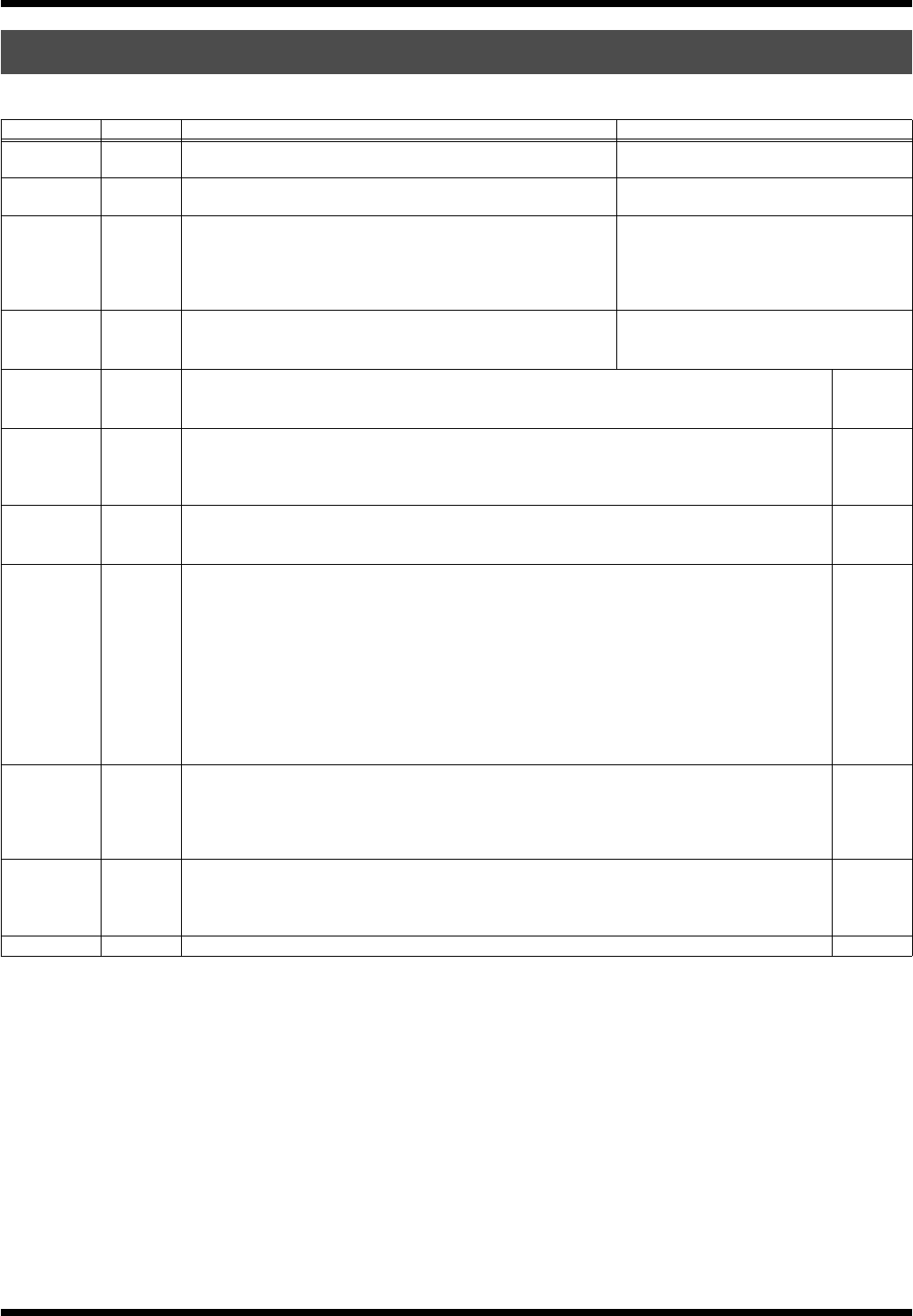
66
Parameter list
These are arpeggio-related settings. Arpeggio parameters are also saved for each patch.
MOTIF
UP(L):
Only the lowest of the keys pressed is sounded each time, and the notes play in order from the lowest of the pressed keys.
UP(L&H):
Notes from both the lowest and highest pressed keys are sounded each time, and the notes play in order from the lowest of the
pressed keys.
UP(-):
The notes play in order from the lowest of the pressed keys. No note is played every time.
DOWN(L):
Only the lowest of the keys pressed is sounded each time, and the notes play in order from the highest of the pressed keys.
DOWN(L&H):
Notes from both the lowest and highest pressed keys are sounded each time, and the notes play in order from the highest of the
pressed keys.
DOWN(-):
The notes play in order from the highest of the pressed keys. No note is played every time.
UP&DOWN(L):
Only the lowest of the keys pressed is sounded each time, and the notes play in order from the lowest of the pressed keys and
then back again in the reverse order.
UP&DOWN(L&H):
Notes from both the lowest and highest pressed keys are sounded each time, and the notes play in order from the lowest of the
pressed keys and then back again in the reverse order.
UP&DOWN(-):
The notes play in order from the lowest of the pressed keys and then back again in the reverse order. No note is played every
time.
RANDOM(L):
Only the lowest of the keys pressed is sounded each time, and the notes play randomly.
RANDOM(-):
The notes play randomly. No note is played every time.
PHRASE:
Pressing just one key plays a phrase based on the pitch of that key. If you press more than one key, the key you press last is used.
ARPEGGIO parameters
Parameter
Value Explanation Panel operation
ARPEGGIO
Switch
OFF, ON Turns the arpeggiator on/off. Press the ARPEGGIO button so it is lit (p. 22)
HOLD OFF, ON The arpeggio will continue playing even if you take your hand off
the keyboard.
Press the ARPEGGIO button so it is blinking
(p. 22)
SPLIT
ARPEGGIO
UPPER,
LOWER,
BOTH
Selects the tone(s) to which the arpeggiator is applied when using
Split (p. 47).
UPPER:
Arpeggiator applied only to the UPPER tone.
LOWER:
Arpeggiator applied only to the LOWER tone.
BOTH:
Arpeggiator applied to both UPPER and LOWER tones.
–
PATCH
TEMPO
5–300
(BPM)
Specifies the tempo of the arpeggiator.
This setting is shared with the PATCH COMMON parameter
PATCH TEMPO (p. 64).
Use the TEMPO buttons, or press the TAP
button three or more times at quarter-note
intervals of the desired timing (p. 22)
OCTAVE
RANGE
-3– +3 Changes the range of the arpeggio.
Adds an effect that shifts arpeggios one cycle at a time in octave units. You can set the shift range
upwards or downwards (up to three octaves up or down).
–
ARPEGGIO
ACCENT
0–100 Changes the accent strength of the arpeggio.
With a setting of “100,” the arpeggiated notes will have the velocities that are programmed by the
arpeggio style.
With a setting of “0,” all arpeggiated notes will be sounded at a fixed velocity.
–
ARPEGGIO
VELOCITY
REAL,
1–127
Specifies the loudness of the notes that you play.
REAL:
The velocity value of each note will depend on how strongly you play the keyboard.
0–127:
Each note will have a fixed velocity regardless of how strongly you play the keyboard.
–
GRID 1/4,
1/8,
1/8L,
1/8H,
1/12,
1/16,
1/16L,
1/16H,
1/24
Sets the particular note division and resolution in a “single grid” used in creating the arpeggio in an
arpeggio style, and how much of a “shuffle” syncopation is to be to applied (none/weak/strong) to it.
1/4:
Quarter note (one grid section = one beat)
1/8:
Eighth note (two grid sections = one beat)
1/8L:
Eighth note shuffle Light (two grid sections = one beat, with a light shuffle)
1/8H:
Eighth note shuffle Heavy (two grid sections = one beat, with a heavy shuffle)
1/12:
Eighth note triplet (three grid sections = one beat)
1/16:
Sixteenth note (four grid sections = one beat)
1/16L:
Sixteenth note shuffle Light (four grid sections = one beat, with a light shuffle)
1/16H:
Sixteenth note shuffle Heavy (four grid sections = one beat, with a heavy shuffle)
1/24:
Sixteenth note triplet (six grid sections = one beat)
–
DURATION 30, 40, 50,
60, 70, 80,
90, 100,
120 (%),
FUL
Determines whether the sounds are played staccato (short and clipped), or tenuto (fully drawn out).
30–120:
For example, when set to “30,” the length of the note in a grid (or when a series of grids is
connected with ties, the final grid) is 30% of the full length of the note set in the GRID.
FUL:
Even if the linked grid is not connected with a tie, the same note continues to sound until the
point at which the next new sound is specified.
–
MOTIF (See be-
low)
Selects the method used to play sounds (motif) when you have a greater number of notes than pro-
grammed for the arpeggio style. (See below.)
When the number of keys played is less than the number of notes in the arpeggio style, the highest-
pitched of the pressed keys is played by default.
–
END STEP 1–32 Specifies the number of steps for the arpeggio style you want to create. –
SH-201_r_e.book 66 ページ 2006年4月27日 木曜日 午前11時28分


















